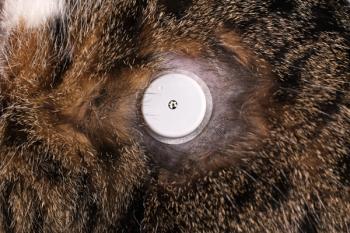
Book excerpt: Why no one should be feeding pets raw meat
A new book from veterinarian Dr. Ernie Ward, writer Alice Oven and pet-food CEO Ryan Bethencourt that argues for a future of plant-derived pet food spends a little time looking at the marketing of domestic pet food that makes raw meat sound like a good idea.
Co-written by well-known veterinarian Dr. Ernie Ward,
Animal meat is the hot trend in pet food, and raw meat blazes the brightest. Magazines, social media, and advertisers may celebrate pets as princes and princesses, but equally strong is the marketing of dogs and cats as wolves and tigers. To manufacture this myth, advertisers use sales terms such as “ancestral,” “biologically appropriate,” and “raw.” An extension of this trend is “fresh,” encompassing the “natural,” “human-grade,” and “raw meat” trends. But raw animal meat has risks. According to the FDA, Centers for Disease Control (CDC), American Veterinary Medical Association, British Small Animal Veterinary Association, Canadian Veterinary Medical Association, World Small Animal Veterinary Association, and a host of other organizations, raw meat pet food is the diet most likely to introduce disease-causing bacteria into our pets and our homes. One study found that in a group of 200 therapy dogs, the incidence of Salmonella in raw-animal-meat-fed dogs was 0.61 cases/dog per year, compared with 0.08 cases/dog per year in dogs that were not fed raw meat.1
Despite these risks, raw animal meat is touted by many as the “premium” of all pet diets. Fortune reported that the growing number of commercial raw-meat-based pet foods has been accompanied by an increase in recalls,2 and an FDA study found significantly higher levels of Salmonella and E. coli in raw pet food samples than in other types of pet foods.3 At the end of January 2019, 33 days into a U.S. government shutdown (when the FDA was only in operation for “imminent threats”), the FDA issued an urgent caution to pet owners not to feed their pets a specific brand of raw food “due to Salmonella and Listeria monocytogenes.” This proves that, despite being officially closed, the FDA was still worried about the public health risk of raw meat pet foods.
Does this mean the FDA is anti-“raw meat pet food”? No, they're pro-“human health.” Contaminated raw animal meats pose a serious health risk to pet owners who handle the foods, packaging, and wastes. Secondary transmission is especially dangerous to children, older persons, and immunocompromised individuals.4 That's why so many medical organizations discourage feeding pets raw animal meats. So why are raw meat diets such a hot trend? A lot of it has to do with astonishingly clever marketing.
Early each day, Alice watches her dog JD chase the pigeons that invade his garden. She knows he has as much chance of catching a soaring bird as he does the squirrels he joyfully pursues in his daydreams. In fact, when JD once found a dead squirrel, he had no idea what it was or what to do with it. JD's instinct wasn't to gnash and devour this “prey,” but to cautiously sniff and retreat. JD's hunting drive might cause him to chase other animals, but he apparently has little desire to kill them. We'd argue that JD and most pet dogs are not killing, carnivorous canine commandos. Yet somehow the assumption that dogs are prehistoric predators lusting to kill other animals persists, and this perception is used as a key marketing message for high-animal protein, raw, and “pure-meat” pet foods. These “ancestral diets” claim that how and what a dog ate millions of years ago is best: natural is healthier.
This cognitive bias is well documented by psychologists as the “appeal to nature” fallacy. It relies on the argument that because something is “natural,” it must somehow be better. That's not necessarily true. Ecology and evolutionary biology professor Marc Bekoff told the authors, “People are swayed by ridiculously misleading advertisements for dog food that go something like “Feed the wolf in your dog.” Dogs aren't wolves, and if they ate like wolves there would be more of an obesity crisis because most dogs don't get near enough exercise.”
Modern animal meats potentially contain many contaminants, toxins, pathogenic bacteria, and added antibiotics and hormones. They're not very “natural.” The “raw meat” fed to a dog or cat today has little relation to the prey a wolf or tiger killed tens of thousands of years ago (or even hundreds). For starters, in the “real wild,” not the “biologically appropriate” or “ancestral” pet food fairyland created by marketers, a wolf or tiger would consume their kill immediately.
This means the fresh meat would have little chance to become contaminated by pathogenic bacteria. There would also be no added antibiotics, hormones, or growth-boosting vitamin and mineral injections. And forget about cows, pigs, chickens, or tuna and salmon. Ancient wolves and dogs had virtually no chance of eating these animals, making them a poor choice as “biologically appropriate.”
The animals that dogs and cats would naturally eat if they had to kill them themselves would primarily be rabbits, squirrels, mice, and whatever dead carcass they lucked across; for cats, it would be small rodents, birds, reptiles, and insects. The species of animal meat we feed our pets today is far from “ancestral” or even “species appropriate.” To compare the fresh kill or scavenging find of a wild cat or coyote with a modern grocery-store-bought “ancestral raw diet” or chicken necks from the butcher is just plain ridiculous. Our domestic dogs and cats no longer hunt for survival, nor are they wild. They are creatures of our creation: mild-mannered, cuddly versions of once proud predators and scavengers. Tens of thousands of years of careful breeding and codependence have made our dogs and cats more similar to us, and completely different from their ancestors.
Raw animal-meat pet food isn't just hurting the environment and farmed animals; it's potentially hurting our pets and our human family, too. In modern domestic society, there are many opportunities for pathogens to contaminate meat between the time an animal is slaughtered and when it reaches the pet bowl. New research5 shows the surprising degree to which germs and parasites can be found in commercial raw-meat products, posing potential health risks to both pets and their owners. Despite denials by raw pet food advocates, raw meat and raw eggs are known to contain harmful bacteria such as E. coli and Salmonella, and feeding excess raw egg whites can cause biotin deficiency in pets. Many proponents of raw food diets boast of their pet's more frequent poops and shinier coats, but the constant pooping is more likely due to lower fiber intake rather than the magical “enzymes” and mysterious “co-factors” purportedly in raw animal flesh. The shiny coat probably is because of high levels of dietary fat, which also has risks such as obesity.
Pet food and feeding has become increasingly integrated into the human kitchen. We no longer store dog food out in the garage next to the toolbox; we keep it in the pantry next to the peanut butter. Few pet owners feed their dogs and cats in their yards anymore; we lovingly place their meals in our dining rooms and kitchens. If you're preparing raw animal meats, this humanization trend inadvertently puts your human family at risk. Wouldn't it be safer to prepare our pets' meat-free vegetable dishes alongside our own? Alice loves to bake extra butternut squash specifically for her spaniel, his favorite food, to supplement his complete, commercially formulated plant-based kibble. Ernie shares his sweet potatoes and chopped carrots with his meat-free terriers. As we'll explore in the next chapters, removing meat from canine diets may have myriad health benefits for dogs and humans.
References
1. Lefebvre SL, et al. Evaluation of the risks of shedding Salmonellae and other potential pathogens by therapy dogs fed raw diets in Ontario and Alberta. Zoonoses Public Health 2008;55(8-10):470-480.
2. Donnelly G. Dog food recall: What pet owners should know. Available at:
3. FDA. Get the facts! Raw pet food diets can be dangerous to you and your pet. Available at:
4. LeJeune JT, Hancock DD. Public health concerns associated with feeding raw meat diets to dogs. J Am Vet Med Assoc 2001;219(9):122-25.
5. van Bree FPJ, Bokken GCAM, Mineur R, et al. Zoonotic bacteria and parasites found in raw meat-based diets for cats and dogs. Vet Rec 2018;182(2):50.
Newsletter
From exam room tips to practice management insights, get trusted veterinary news delivered straight to your inbox—subscribe to dvm360.






